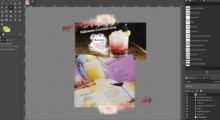Using GIMP from my own program
This discussion is connected to the gimp-developer-list.gnome.org mailing list which is provided by the GIMP developers and not related to gimpusers.com.
This is a read-only list on gimpusers.com so this discussion thread is read-only, too.
| Using GIMP from my own program | Pablo Yaggi | 14 Dec 16:39 |
| Using GIMP from my own program | Martin Nordholts | 14 Dec 16:50 |
| Using GIMP from my own program | Pablo Yaggi | 14 Dec 17:48 |
| Using GIMP from my own program | Martin Nordholts | 14 Dec 17:57 |
| Using GIMP from my own program | Pablo Yaggi | 14 Dec 18:24 |
| Using GIMP from my own program | Martin Nordholts | 14 Dec 18:59 |
| Using GIMP from my own program | Pablo Yaggi | 14 Dec 19:07 |
| Using GIMP from my own program | saulgoode@flashingtwelve.brickfilms.com | 14 Dec 19:36 |
| Using GIMP from my own program | Pablo Yaggi | 16 Dec 15:52 |
| Using GIMP from my own program | Pablo Yaggi | 16 Dec 16:30 |
| Using GIMP from my own program | saulgoode@flashingtwelve.brickfilms.com | 16 Dec 18:45 |
| Using GIMP from my own program | Pablo Yaggi | 16 Dec 20:45 |
| Using GIMP from my own program | David Gowers | 16 Dec 21:24 |
Using GIMP from my own program
Hi, is it possible to use gimp from a C program ?
I want to open an image use some plugin on it and
save it. I know perl does something like that, but
I couldn't find info about that, could somebody
point me in a good direction ?
Bests,
Pablo
Using GIMP from my own program
Pablo Yaggi wrote:
Hi, is it possible to use gimp from a C program ?
I want to open an image use some plugin on it and
save it. I know perl does something like that, but
I couldn't find info about that, could somebody
point me in a good direction ?
Bests,
Pablo
Hi!
The different language wrappers for GIMP such as Perl, Python or Scheme are themselves basically just wrappers for the PDB, Procedural DataBase. If you want to call a PDB procedure from GIMP plug-in written in C you would use gimp_run_procedure() [1] or gimp_run_procedure2(). (These are the functions the language wrappers themselves use (the language wrappers are themselves plug-ins)).
BR, Martin
[1]
http://developer.gimp.org/api/2.0/libgimp/libgimp-gimp.html#gimp-run-procedure
Using GIMP from my own program
But I don't want to call it from a gimp plugin, I want to call it from
inside a simple c program, is it possible ?
I mean using libgimp outside Gimp, just linking to it, if it so
I suppose I need to make some initialization and I should
need to create some type of data object and so, any example ?
Best Regards
Pablo
On Sunday 14 December 2008 13:50:25 Martin Nordholts wrote:
Pablo Yaggi wrote:
Hi, is it possible to use gimp from a C program ?
I want to open an image use some plugin on it and
save it. I know perl does something like that, but
I couldn't find info about that, could somebody
point me in a good direction ?
Bests,
Pablo
Hi!
The different language wrappers for GIMP such as Perl, Python or Scheme are themselves basically just wrappers for the PDB, Procedural DataBase. If you want to call a PDB procedure from GIMP plug-in written in C you would use gimp_run_procedure() [1] or gimp_run_procedure2(). (These are the functions the language wrappers themselves use (the language wrappers are themselves plug-ins)).
BR, Martin
[1]
http://developer.gimp.org/api/2.0/libgimp/libgimp-gimp.html#gimp-run-proced ure
Using GIMP from my own program
Pablo Yaggi wrote:
But I don't want to call it from a gimp plugin, I want to call it from
inside a simple c program, is it possible ?
I mean using libgimp outside Gimp, just linking to it, if it so
I suppose I need to make some initialization and I should
need to create some type of data object and so, any example ?
Best Regards
Pablo
The GIMP plug-ins are not available as a statically linkable libraries (with perhaps some corner cases such as the libflame based plug-in). Keep in mind that plug-ins are separate executables/processes that communicate with the GIMP core through a pipe.
Maybe you can find the filter you want in the GEGL framework which you can link statically/dynamically as any library and extend with your own operations.
- Martin
Using GIMP from my own program
So ..., I think a couple of things are not clear to me about gimp,
if plugins communicate with the core of gimp thought a pipe, I
should be able to create a plugin to do what i want, even
call other plugins, but could that plugin be executed from outside
the core ?, even so it is necesary that gimp is running before
doing it ? are the core and gui strict releated, i mean are the same
thing? can the gui be down, and the core working ?
In other words, is it possible in any way to use gimp for
automatic image processing/generating, because GEGL its very
promissing but gimp is fully charged with plugins and tools,
and It sould be very nice to use all that power for automatic
process.
Pablo
On Sunday 14 December 2008 14:57:18 Martin Nordholts wrote:
Pablo Yaggi wrote:
But I don't want to call it from a gimp plugin, I want to call it from
inside a simple c program, is it possible ?
I mean using libgimp outside Gimp, just linking to it, if it so
I suppose I need to make some initialization and I should
need to create some type of data object and so, any example ?
Best Regards
Pablo
The GIMP plug-ins are not available as a statically linkable libraries (with perhaps some corner cases such as the libflame based plug-in). Keep in mind that plug-ins are separate executables/processes that communicate with the GIMP core through a pipe.
Maybe you can find the filter you want in the GEGL framework which you can link statically/dynamically as any library and extend with your own operations.
- Martin
Using GIMP from my own program
Pablo Yaggi wrote:
So ..., I think a couple of things are not clear to me about gimp,
if plugins communicate with the core of gimp thought a pipe, I
should be able to create a plugin to do what i want, even
call other plugins, but could that plugin be executed from outside
the core ?
All plug-ins are executed outside the core as a separate process. Plug-ins registers procedures that other plug-ins, typically language wrappers, can call. GIMP takes care of inter-process communication.
, even so it is necesary that gimp is running before
doing it ? are the core and gui strict releated, i mean are the same
thing? can the gui be down, and the core working ?
In other words, is it possible in any way to use gimp for
automatic image processing/generating, because GEGL its very
promissing but gimp is fully charged with plugins and tools,
and It sould be very nice to use all that power for automatic
process.
Pablo
GIMP has non-interactive and batch processing modes but I do not use these very often so I don't have any further details to give than to refer to Google and the GIMP source code.
- Martin
Using GIMP from my own program
Ok, then I keep googling and I'll check gegl a little deep,
thank's Martin,
BR,
Pablo
On Sunday 14 December 2008 15:59:59 Martin Nordholts wrote:
Pablo Yaggi wrote:
So ..., I think a couple of things are not clear to me about gimp,
if plugins communicate with the core of gimp thought a pipe, I
should be able to create a plugin to do what i want, even
call other plugins, but could that plugin be executed from outside
the core ?
All plug-ins are executed outside the core as a separate process. Plug-ins registers procedures that other plug-ins, typically language wrappers, can call. GIMP takes care of inter-process communication.
, even so it is necesary that gimp is running before
doing it ? are the core and gui strict releated, i mean are the same
thing? can the gui be down, and the core working ?
In other words, is it possible in any way to use gimp for
automatic image processing/generating, because GEGL its very
promissing but gimp is fully charged with plugins and tools,
and It sould be very nice to use all that power for automatic
process.
Pablo
GIMP has non-interactive and batch processing modes but I do not use these very often so I don't have any further details to give than to refer to Google and the GIMP source code.
- Martin
Using GIMP from my own program
Quoting Pablo Yaggi :
So ..., I think a couple of things are not clear to me about gimp, if plugins communicate with the core of gimp thought a pipe, I should be able to create a plugin to do what i want, even call other plugins, but could that plugin be executed from outside the core ?, ...
Yes.
even so it is necesary that gimp is running before doing it ?
Yes, if you want to use plug-ins or scripts then you will want GIMP to be running (unless you want to reimplement all of the functionality of handling those plug-ins using libgimp).
are the core and gui strict releated, i mean are the same thing? can the gui be down, and the core working ?
Yes, you can execute GIMP without the GUI by passing the '--no-interface' ('-i') option on the command line. Script-fu code can be passed to GIMP on the command line as well, if you know what that code is in advance. If you need a more interactive approach, you could also have GIMP running in a server mode where Script-fu commands are passed over TCP.
In other words, is it possible in any way to use gimp for automatic image processing/generating, because GEGL its very promissing but gimp is fully charged with plugins and tools, and It sould be very nice to use all that power for automatic process.
First, I would propose that you investigate Imagemagick command line tools ( http://www.imagemagick.org/ ) and see if they present a better solution.
Second, you should investigate using GEGL. It is particularly targeted for the type of activity you are pursuing and your participation could help advance its progress.
If neither of those two options seem desirable then I would present the following GIMP-based options:
1) Invoke GIMP from your C program, passing the commands you wish executed as Script-fu in batch mode ('-b').
2) If you need lower level processing than provided by Script-fu,
write your code as a GIMP plug-in and invoke your plug-in from a batch
Script-fu command. Example:
gimp -i -b '(plug-in-pablos-function RUN-NONINTERACTIVE parameter1
parameter2)' -b '(quit 0)'
3) Run an interactive server, as briefly described in this ML posting:
(
http://flashingtwelve.brickfilms.com:2095/horde/imp/message.php?index=11369
)
4) Write your code as a GIMP plug-in per the tutorial described here: ( http://gimp.org/docs/plug-in/sect-essentials.html )
however, you should register an 'init' procedure which invokes your plug-in (perhaps passing it command line parameters).
This will have the effect of your plug-in automatically being executed
when GIMP is run; therefore do NOT put your autoexecuted plug-in into
the standard GIMP plug-in folders (or you will "break" normal usage of
GIMP). Instead, create a custom gimprc file (e.g.,
"$HOME/gimprc.pablo") which adds the path of your autoexecuted plug-in
to the plug-in search path:
(plug-in-path
"${gimp_dir}/plug-ins:$HOME/.gimp-2.6/plug-ins:$HOME/autoexec/plug-ins")
You then can invoke GIMP, specifying the alternate gimprc: gimp -i -g $HOME/gimprc.pablo
=======================
There is little difference between 2) and 4) in net effect, but I thought I would try to explain it anyway (I have never tried the fourth method). Usually the 'init' procedure is not used for individual plug-ins -- it is used to configure things for entire packages of multiple plug-ins (such as Python-fu or the GIMP Animation Package).
Using GIMP from my own program
Well, following all advices I decide to make the plugins I need for gimp, and use it in batch mode, this way plugins will be available for everybody. But my first attempt is not working fine, I'm coping/pasting the following code into the script-fu console, and I get a black image as glam-out.jpg with correct size, could you tell me why ?, (this is a test that should make an image which is double in height than input, and the upper half size has the input copied as is and the lower half size has the input copied rotated 180)
(let* (
(image (car(gimp-file-load 1 "/home/pablo/glam.jpg"
"/home/pablo/glam.jpg")))
(width (car (gimp-image-width image)))
(height (car (gimp-image-height image)))
(newheight (* height 2))
(newimage (car(gimp-image-new width newheight RGB)))
(newlayer (car (gimp-layer-new newimage width newheight RGBA-IMAGE
"Copy" 100 NORMAL-MODE)))
)
(gimp-context-push)
(gimp-image-add-layer newimage newlayer -1)
(gimp-drawable-set-visible newlayer TRUE)
(gimp-selection-all image)
(gimp-edit-copy-visible image)
(gimp-rect-select newimage 0 0 width height CHANNEL-OP-ADD FALSE 0)
(let ((floating-sel (car (gimp-edit-paste newimage FALSE))))
(gimp-floating-sel-anchor floating-sel)
)
(gimp-selection-none newimage)
(gimp-rect-select newimage 0 height width height CHANNEL-OP-ADD FALSE 0)
(let ((floating-sel (car (gimp-edit-paste newimage FALSE))))
(gimp-rotate floating-sel FALSE 180)
(gimp-floating-sel-anchor floating-sel)
)
(gimp-file-save 1 newimage newlayer "/home/pablo/glam-out.jpg"
"/home/pablo/glam-out.jpg")
(gimp-context-pop) )
Best Regards,
Pablo
On Sunday 14 December 2008 16:36:10 saulgoode@flashingtwelve.brickfilms.com wrote:
Quoting Pablo Yaggi :
So ..., I think a couple of things are not clear to me about gimp, if plugins communicate with the core of gimp thought a pipe, I should be able to create a plugin to do what i want, even call other plugins, but could that plugin be executed from outside the core ?, ...
Yes.
even so it is necesary that gimp is running before doing it ?
Yes, if you want to use plug-ins or scripts then you will want GIMP to be running (unless you want to reimplement all of the functionality of handling those plug-ins using libgimp).
are the core and gui strict releated, i mean are the same thing? can the gui be down, and the core working ?
Yes, you can execute GIMP without the GUI by passing the '--no-interface' ('-i') option on the command line. Script-fu code can be passed to GIMP on the command line as well, if you know what that code is in advance. If you need a more interactive approach, you could also have GIMP running in a server mode where Script-fu commands are passed over TCP.
In other words, is it possible in any way to use gimp for automatic image processing/generating, because GEGL its very promissing but gimp is fully charged with plugins and tools, and It sould be very nice to use all that power for automatic process.
First, I would propose that you investigate Imagemagick command line tools ( http://www.imagemagick.org/ ) and see if they present a better solution.
Second, you should investigate using GEGL. It is particularly targeted for the type of activity you are pursuing and your participation could help advance its progress.
If neither of those two options seem desirable then I would present the following GIMP-based options:
1) Invoke GIMP from your C program, passing the commands you wish executed as Script-fu in batch mode ('-b').
2) If you need lower level processing than provided by Script-fu, write your code as a GIMP plug-in and invoke your plug-in from a batch Script-fu command. Example:
gimp -i -b '(plug-in-pablos-function RUN-NONINTERACTIVE parameter1 parameter2)' -b '(quit 0)'3) Run an interactive server, as briefly described in this ML posting: (
http://flashingtwelve.brickfilms.com:2095/horde/imp/message.php?index=11369 )4) Write your code as a GIMP plug-in per the tutorial described here: ( http://gimp.org/docs/plug-in/sect-essentials.html )
however, you should register an 'init' procedure which invokes your plug-in (perhaps passing it command line parameters).
This will have the effect of your plug-in automatically being executed when GIMP is run; therefore do NOT put your autoexecuted plug-in into the standard GIMP plug-in folders (or you will "break" normal usage of GIMP). Instead, create a custom gimprc file (e.g., "$HOME/gimprc.pablo") which adds the path of your autoexecuted plug-in to the plug-in search path:
(plug-in-path
"${gimp_dir}/plug-ins:$HOME/.gimp-2.6/plug-ins:$HOME/autoexec/plug-ins")You then can invoke GIMP, specifying the alternate gimprc: gimp -i -g $HOME/gimprc.pablo
=======================
There is little difference between 2) and 4) in net effect, but I thought I would try to explain it anyway (I have never tried the fourth method). Usually the 'init' procedure is not used for individual plug-ins -- it is used to configure things for entire packages of multiple plug-ins (such as Python-fu or the GIMP Animation Package).
Using GIMP from my own program
Ok, I made it work, I just replaced newlayer for newimage in the
gimp-edit-paste call and it worked.
But pasting into the image should work, shouldn't ?, do I have
to set up a current layer or something ?
bests,
Pablo
On Tuesday 16 December 2008 12:52:49 Pablo Yaggi wrote:
Well, following all advices I decide to make the plugins I need for gimp, and use it in batch mode, this way plugins will be available for everybody. But my first attempt is not working fine, I'm coping/pasting the following code into the script-fu console, and I get a black image as glam-out.jpg with correct size, could you tell me why ?, (this is a test that should make an image which is double in height than input, and the upper half size has the input copied as is and the lower half size has the input copied rotated 180)
(let* ( (image (car(gimp-file-load 1 "/home/pablo/glam.jpg" "/home/pablo/glam.jpg")))
(width (car (gimp-image-width image))) (height (car (gimp-image-height image))) (newheight (* height 2))
(newimage (car(gimp-image-new width newheight RGB))) (newlayer (car (gimp-layer-new newimage width newheight RGBA-IMAGE "Copy" 100 NORMAL-MODE)))
)
(gimp-context-push)(gimp-image-add-layer newimage newlayer -1) (gimp-drawable-set-visible newlayer TRUE) (gimp-selection-all image)
(gimp-edit-copy-visible image)
(gimp-rect-select newimage 0 0 width height CHANNEL-OP-ADD FALSE 0) (let ((floating-sel (car (gimp-edit-paste newimage FALSE)))) (gimp-floating-sel-anchor floating-sel) )
(gimp-selection-none newimage)
(gimp-rect-select newimage 0 height width height CHANNEL-OP-ADD FALSE 0) (let ((floating-sel (car (gimp-edit-paste newimage FALSE)))) (gimp-rotate floating-sel FALSE 180) (gimp-floating-sel-anchor floating-sel) )
(gimp-file-save 1 newimage newlayer "/home/pablo/glam-out.jpg" "/home/pablo/glam-out.jpg")(gimp-context-pop) )
Best Regards,
PabloOn Sunday 14 December 2008 16:36:10 saulgoode@flashingtwelve.brickfilms.com
wrote:
Quoting Pablo Yaggi :
So ..., I think a couple of things are not clear to me about gimp, if plugins communicate with the core of gimp thought a pipe, I should be able to create a plugin to do what i want, even call other plugins, but could that plugin be executed from outside the core ?, ...
Yes.
even so it is necesary that gimp is running before doing it ?
Yes, if you want to use plug-ins or scripts then you will want GIMP to be running (unless you want to reimplement all of the functionality of handling those plug-ins using libgimp).
are the core and gui strict releated, i mean are the same thing? can the gui be down, and the core working ?
Yes, you can execute GIMP without the GUI by passing the '--no-interface' ('-i') option on the command line. Script-fu code can be passed to GIMP on the command line as well, if you know what that code is in advance. If you need a more interactive approach, you could also have GIMP running in a server mode where Script-fu commands are passed over TCP.
In other words, is it possible in any way to use gimp for automatic image processing/generating, because GEGL its very promissing but gimp is fully charged with plugins and tools, and It sould be very nice to use all that power for automatic process.
First, I would propose that you investigate Imagemagick command line tools ( http://www.imagemagick.org/ ) and see if they present a better solution.
Second, you should investigate using GEGL. It is particularly targeted for the type of activity you are pursuing and your participation could help advance its progress.
If neither of those two options seem desirable then I would present the following GIMP-based options:
1) Invoke GIMP from your C program, passing the commands you wish executed as Script-fu in batch mode ('-b').
2) If you need lower level processing than provided by Script-fu, write your code as a GIMP plug-in and invoke your plug-in from a batch Script-fu command. Example:
gimp -i -b '(plug-in-pablos-function RUN-NONINTERACTIVE parameter1 parameter2)' -b '(quit 0)'3) Run an interactive server, as briefly described in this ML posting: (
http://flashingtwelve.brickfilms.com:2095/horde/imp/message.php?index=113 69 )4) Write your code as a GIMP plug-in per the tutorial described here: ( http://gimp.org/docs/plug-in/sect-essentials.html )
however, you should register an 'init' procedure which invokes your plug-in (perhaps passing it command line parameters).
This will have the effect of your plug-in automatically being executed when GIMP is run; therefore do NOT put your autoexecuted plug-in into the standard GIMP plug-in folders (or you will "break" normal usage of GIMP). Instead, create a custom gimprc file (e.g., "$HOME/gimprc.pablo") which adds the path of your autoexecuted plug-in to the plug-in search path:
(plug-in-path
"${gimp_dir}/plug-ins:$HOME/.gimp-2.6/plug-ins:$HOME/autoexec/plug-ins")You then can invoke GIMP, specifying the alternate gimprc: gimp -i -g $HOME/gimprc.pablo
=======================
There is little difference between 2) and 4) in net effect, but I thought I would try to explain it anyway (I have never tried the fourth method). Usually the 'init' procedure is not used for individual plug-ins -- it is used to configure things for entire packages of multiple plug-ins (such as Python-fu or the GIMP Animation Package).
Using GIMP from my own program
Quoting Pablo Yaggi :
Ok, I made it work, I just replaced newlayer for newimage in the gimp-edit-paste call and it worked.
But pasting into the image should work, shouldn't ?, do I have to set up a current layer or something ?
There is no "paste-as-new-layer" function provided as such by the PDB interface (though there is a menu command for that) and so you must perform a couple of separate functions to achieve the same result.
You do not need to set up a current layer, but you need to perform a 'gimp-floating-sel-to-layer' after your 'gimp-edit-paste'. This will result in a new layer at the top of the layerstack -- unlike the menu command, which places the new layer above the active layer -- and therefore it does not matter which layer (or drawable) is active at the time the paste is performed.
If you instead wish the resulting new layer to appear just above the current layer then you will need to make note of the current layer's position (using 'gimp-image-get-layer-position') and lower the pasted layer accordingly (using 'gimp-image-lower-layer' the appropriate number of times).
Using GIMP from my own program
Now I have my script running, It's a simple script that produces the
table-mirror effect apple does, but is it possible to check whether
the interface is available or not, I mean if gimp is running with -i mode
(no interface).
Also, the script resizes the original image, is it possible to change the
actual zoom from inside the script? how ?
Bests,
Pablo
On Tuesday 16 December 2008 15:45:15 saulgoode@flashingtwelve.brickfilms.com wrote:
Quoting Pablo Yaggi :
Ok, I made it work, I just replaced newlayer for newimage in the gimp-edit-paste call and it worked.
But pasting into the image should work, shouldn't ?, do I have to set up a current layer or something ?There is no "paste-as-new-layer" function provided as such by the PDB interface (though there is a menu command for that) and so you must perform a couple of separate functions to achieve the same result.
You do not need to set up a current layer, but you need to perform a 'gimp-floating-sel-to-layer' after your 'gimp-edit-paste'. This will result in a new layer at the top of the layerstack -- unlike the menu command, which places the new layer above the active layer -- and therefore it does not matter which layer (or drawable) is active at the time the paste is performed.
If you instead wish the resulting new layer to appear just above the current layer then you will need to make note of the current layer's position (using 'gimp-image-get-layer-position') and lower the pasted layer accordingly (using 'gimp-image-lower-layer' the appropriate number of times).
Using GIMP from my own program
Hi,
On Wed, Dec 17, 2008 at 6:15 AM, Pablo Yaggi wrote:
Now I have my script running, It's a simple script that produces the
table-mirror effect apple does, but is it possible to check whether
the interface is available or not, I mean if gimp is running with -i mode
(no interface).
No, there is no reliable way to do that AFAIK.
Also, the script resizes the original image, is it possible to change the
actual zoom from inside the script? how ?
No. In python scripting this is possible using software like 'xdotool', but not in script-fu (because there is no command to shell out and run another command).
After looking at your script, I suggest you also use '--no-data' commandline parameter to GIMP to cut down on memory usage and startup time, since you don't appear to use any brushes/gradients etc in your script.
David











